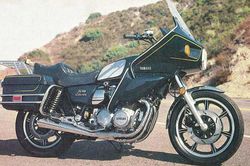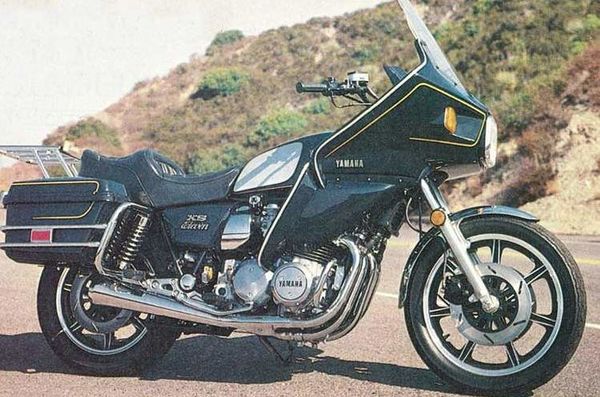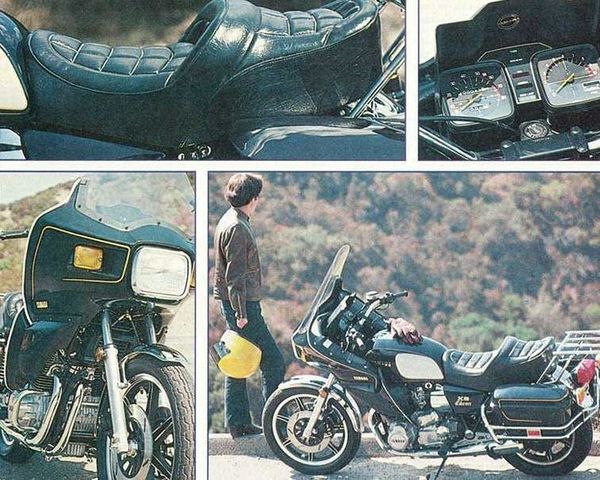Yamaha XS1100 Venturer
 |
|
| Yamaha XS1100 Venturer | |
| Manufacturer | |
|---|---|
| Production | 1981 |
| Class | Standard |
| Engine | Four stroke transverse four cylinder, DOHC, 2 valves per cylinder. |
| Compression ratio | 9.2:1 |
| Ignition | TCI additional vacuum adjusted! / electric kick starter - Witch is separated from the engine, for emergency mounting only |
| Spark Plug | BP6ES (NGK) or N-8Y (Champion) |
| Battery | GM 18Z-3A / 12v, 20 AH |
| Transmission | 5 Speed |
| Suspension | Front: Telescopic fork. Rear: Dual shocks Swing arm, preload adjustable |
| Brakes | Front: 2x 298mm discs Rear: Single 298mm disc |
| Front Tire | 3.50-19 |
| Rear Tire | 4.50-17 |
| Seat Height | 800 mm / 31.5 in |
| Weight | 287kg / 633 lb (wet) |
| Recommended Oil | Yamalube 10w-40 |
| Fuel Capacity | 22 Liters / 5.8 gal |
| Manuals | Service Manual |
Engine[edit | edit source]
The engine was a Air cooled cooled Four stroke transverse four cylinder, DOHC, 2 valves per cylinder.. The engine featured a 9.2:1 compression ratio.
Drive[edit | edit source]
Power was moderated via the Wet, multi-disc (8 drive plates, 7 driven plates).
Chassis[edit | edit source]
It came with a 3.50-19 front tire and a 4.50-17 rear tire. Stopping was achieved via 2x 298mm discs in the front and a Single 298mm disc in the rear. The front suspension was a Telescopic fork. while the rear was equipped with a Dual shocks Swing arm, preload adjustable. The XS1100 Venturer was fitted with a 22 Liters / 5.8 gal fuel tank.
Photos[edit | edit source]
Overview[edit | edit source]
Yamaha XS 1100 Venturer
Road Test 1981
Yamaha has finally ventured into the brave new
world of turn-key touring. And the tongue-twisting name chosen for these
ready-to-travel long-distance bikes is, appropriately enough, Venturer. There
are even two of them for potential gypsies to choose froman XS850 Triple and an
XS1100 Four.
Both Venturers are based on the civilian line of
XS-series street bikes (read: non-Specials); what's more, you can't even get one
of those plain-Jane XS850s or XS1100s without the Venturer touring equipment
already attached. The reason, according to Yamaha, is that the number of
optionally tour-dressed 850s and Elevens that have rolled off showroom floors in
the past couple of years has increased dramatically. So to meet that demand, and
to simplify things for the dealers, Yamaha has decided that every non-Special
850 and 1100 will now come with a fairing arid its attendant touring hardware.
Period.
One highly influential factor affecting Yamaha's
decision to enter the turn-key game was touring equipmentor, more specifically,
the lack of its availability from YPDI (Yamaha Parts Distributors, Inc.), the
parts and accessories arm of Yamaha in the U.S. The shortage was brought about
partly by strong growth in the touring segment of the marketplace, and partly by
a sales-incentive program initiated by Yamaha prior to the 1980 model year. That
program encouraged dealers to buy lots and lots of touring equipment--and it
worked. Too well. Yamaha didn't expect the overwhelming number of orders it
received for touring bolt-ons. So instead of enjoying a smooth outflow of parts,
Yamaha found itself with empty warehouses, a logjam of backorders and a
multitude of unhappy owners.
Yamaha's game plan for 1981, however, guarantees
that for every new standard-issue 850 and 1100that company's two most-popular
recipients of touring gearthere will be a fairing, saddlebags and all the usual
chromeware included. In effect, then, the Venturer is similar to Honda's GL1100
Interstate in that it can roll off of the dealer's sales floor ready to ramble
down the vehicular arteries of America.
In other ways, though, Yamaha's turn-key program
differs slightly from Honda's. Where Honda makes all of its Interstate wrappings
in Japan and then ships a single package across the Pacific, the Yamahas
rendezvous with their touring hardware Over Here, simply because this is where
those pieces are made.
Manufacturing differences aside, though, Yamaha's
marketing people make no bones about the fact that the XS1100-based Venturer is
aimed dead-center at the Interstate. They fully expect that even the most
weathered of horizon-chasers will shop at Honda and Yamaha dealerships before
deciding which 1100cc motorhome they want to own. So by having a complete
touring package for sale, and at a competitive price as well, Yamaha dealers now
have a better shot at keeping some potential Interstate owners riding behind the
sign of the crossed tuning forks.
Yamaha dealers shouldn't have much trouble
keeping their newly acquired turn-key touring clientele in replacement parts,
since all of the Venturer's over-the-road wares can be found in the YPDI
catalog. The fairing is much the same as the one listed in the 1980 wishbook,
and it's designed specifically for the standard XS Eleven. So the stock halogen
headlight, for instance, fitswell, like the fairing was made for it. The
package also includes ABS plastic lowers for the fairing that knife through the
cold with great efficiency, but the problem is that they don't have any sort of
tunnel vents to direct fresh air into the cockpit. Meaning that when the weather
gets uncomfortably hot, so do youunless you detach them.
Yamaha did find a cure for one problem that
bothered previous fairing-equipped XS Elevens: nighttime windshield glare. It
was caused by reflections from the illuminated instruments, but that fugitive
light is intercepted on the Venturer by a matte-black sheetmetal shroud mounted
atop the dash panel. The shroud looks kind of silly, sticking way up about six
inches, but it works. You won't see the reflected faces of the speedometer and
tachometer on this windshield at night.
You also won't see a travel trunk on the
Venturer, night or day. Yamaha intended to equip each bike with one, but the
company that actually makes them couldn't supply enough to meet the production
demands. So in its place is a useful but less-practical luggage rack. Venturer
owners will have to buy aftermarket trunks on their own, but YPDI spokesmen say
that an OEM trunk is planned for 1982 turnkey touring Yamahas.
Even without the trunk, though, there's plenty of
space in the two fiberglass saddlebags. New bracketry repositions the bags
closer to the bike than last year's Eleven offerings; and side-hinged lids
replace the fully detachable lids that too often fell off of pre-1980 YPDI bags.
Unfortunately, there's not enough room in the bags to stow your helmet, so
you'll have to leave that job to the helmet lock on the side of the motorcycle.
Yamaha turn-key development didn't involve just
adding pieces to the stock Eleven; in the interest of increasing the riding
range, the gas-tank capacity grew from 5.8 to 6.5 gallons. Those supertanker
specs will allow you to cover more than 300 miles between fuel stopsa distance
that surely is more than your buttocks can stand, even with the new contoured
bucket seat that parks you about an inch and a half closer to the ground than
before. And to help support your load of traveling gear, the shock springs have
been up-rated so they won't sag as easily when overworked. The shocks themselves
have the same four-way-adjustable rebound damping and five-way-adjustable spring
preload as on previous XS Elevens.
Not so the shorty mufflers on the Venturer, which
were grafted from the Eleven Special for cosmetic purposes only. These upswept
pipes presented a potential problem, however, in that they empty the exhaust
right toward the bottoms of the saddlebags. So to avoid hot pants in the luggage
compartments, metal heatshields are rubber-mounted to the bottoms of the bags.
They provide a buffer air space between the saddlebags and their contents,
hopefully preventing the Eleven's BTUs from incinerating your BVDs.
Things like that offer strong evidence that the
Venturer isn't Yamaha's final solution to turn-key touring for the wandering
masses. But the bike does underline the significance that touring currently has
in the marketplace. Whether the hard-to-say name "Venturer" remains after the
1981 season will be determined by Yamaha's product planners, but the verdict on
the bike's concept is up to the public. If past YPDI sales recordsand those of
Honda's Interstate, as wellare any indication, that verdict is already in.
Source Cycle Guide 1981
| Year | 1981 |
|---|---|
| Engine Type | Four stroke transverse four cylinder, DOHC, 2 valves per cylinder. |
| Displacement | 1101 cc / 67.2 cu-in |
| Bore X Stroke | 71.5 x 68.6 mm |
| Cooling System | Air cooled |
| Compression | 9.2:1 |
| Induction | 4x Mikuni BS 34SS Carburettor |
| Lubrication | Wet sump |
| Ignition | TCI additional vacuum adjusted! / electric kick starter - Witch is separated from the engine, for emergency mounting only |
| Spark Plug | BP6ES (NGK) or N-8Y (Champion) |
| Battery | GM 18Z-3A / 12v, 20 AH |
| Generator | A.C. Generator, voltage regulator, rectifier |
| Starting | Electric |
| Max Power | 95 hp / 70.8 kW @ 8500 rpm |
| Max Torque | 9.2 kgf-m / 66.5 lb-ft @ 6500 rpm |
| Clutch | Wet, multi-disc (8 drive plates, 7 driven plates) |
| Transmission | 5 Speed |
| Primary Reduction System | HY-VO chain & gear |
| Primary Reduction Ratio | 25/25 x 58/35 = 1.657 |
| Final Drive | Shaft |
| Gear Ratio | 1st 38/17 (2.235) 2nd 39/24 (1.625) 3rd 36/28 (1.286) 4th 32/31 (1.032) 5th 30/34 (0.882) |
| Front Suspension | Telescopic fork. |
| Front Wheel Travel | 175 mm / 6.8 in |
| Rear Suspension | Dual shocks Swing arm, preload adjustable |
| Rear Wheel Travel | 80 mm / 3.1 in |
| Front Brakes | 2x 298mm discs |
| Rear Brakes | Single 298mm disc |
| Front Tire | 3.50-19 |
| Rear Tire | 4.50-17 |
| Rake | 29º 30 |
| Trail | 130 mm / 5.1 in |
| Seat Height | 800 mm / 31.5 in |
| Wet Weight | 287kg / 633 lb |
| Fuel Capacity | 22 Liters / 5.8 gal |

